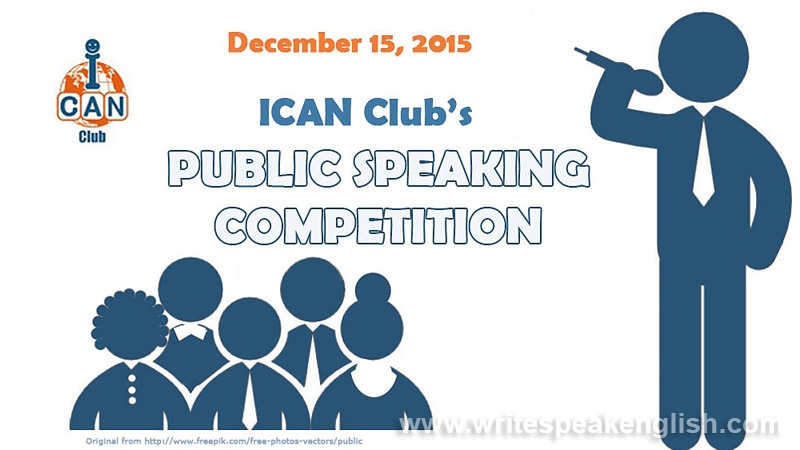
Public Speaking Competition in ICAN Club
- By (Val) Valiantsina Holubeva
- Posted Dec 9, 2015
Get ready to face the greatest challenge of 2015 in ICAN Club:
Public Speaking Competition.
Strong public speaking skills is a way to increase your influence, to inspire and to lead, to succeed with your mission and improve your standing. Stop complaining that people won't listen to you - learn how to get a message across, to convince and to share.
This competition will finish a two-month training in effective speaking, and it will open the way to the inter-school Public Speaking Contest.
Although six participants will get awards in the in-Club competition, only three will be chosen to represent our ICAN Club at the Public Speaking Contest on December 19, 2015, with good prizes, professional feedback, and fame. It's a challenge. But it is worth trying. Winning a prize is pleasant, but it is far more important to get over shyness, gain confidence, get rid of mistakes and develop fluency. The purpose of the Competition is to help you do this. Once you've signed up for the Competition, you will get the materials and will be eligible to free mentoring.
Please, scroll down to read the preparation tips in the comments.
Date: December 15, 2015
Time: 6.30 to 8.45 p.m.
Venue: 51 Karalya St. Map
Price: 135,000 BYR minus discounts Prices
Awards:
Registration Deadline: Midnight on Monday December 14, 2015
Public Speaking Competition.
Strong public speaking skills is a way to increase your influence, to inspire and to lead, to succeed with your mission and improve your standing. Stop complaining that people won't listen to you - learn how to get a message across, to convince and to share.
This competition will finish a two-month training in effective speaking, and it will open the way to the inter-school Public Speaking Contest.
Although six participants will get awards in the in-Club competition, only three will be chosen to represent our ICAN Club at the Public Speaking Contest on December 19, 2015, with good prizes, professional feedback, and fame. It's a challenge. But it is worth trying. Winning a prize is pleasant, but it is far more important to get over shyness, gain confidence, get rid of mistakes and develop fluency. The purpose of the Competition is to help you do this. Once you've signed up for the Competition, you will get the materials and will be eligible to free mentoring.
Please, scroll down to read the preparation tips in the comments.
Date: December 15, 2015
Time: 6.30 to 8.45 p.m.
Venue: 51 Karalya St. Map
Price: 135,000 BYR minus discounts Prices
Awards:
| Nominations | 1st place | 2nd place | 3d place |
| Confident Speakers | one free ticket to ICAN Club | 50% discount | 25% discount |
| Budding Talents | one free ticket to ICAN Club | 50% discount | 25% discount |
Registration Deadline: Midnight on Monday December 14, 2015








Comments (6)
By Val 09.12.2015
By Val 09.12.2015
Step 1: Self-presentation.
It would be a good idea to watch the beginnings of TED talks to see how speakers present themselves and pick up words. Then start preparing your own self-presentation:
1.1. WRITE your self presentation, focusing on one major message
A TIP: do not write anything you do not feel comfortable about.
1.2. delete everything you can delete,
1.3. add what makes you special
1.4. allow time for pauses and emphasis.
1.5. Once you have done this, proofread it,
A TIP: Copy-paste your text into https://translate.google.com and listen to it. You will hear your mistakes, if any.
You can also send it to me to check.
1.6. Practice pronouncing your self-presentation EVERY DAY in front of the mirror until you feel free and confident.
By Val 09.12.2015
a) Start preparing for Task 2. Think, what you would like to tell the world. You can promote an idea, a project, a person, etc.
Write your idea in a short clear-cut sentence. Use exact colorful words to make your sentence remarkable.
b) Practice pronunciation. Remember to move your mouth.
Here are some tongue twisters from Fluency MC (a.k.a Jason R. Levine)
https://www.youtube.com/watch?v=iOqlPXvnG34
Work on sounds with EnglishCentral.com
http://www.englishcentral.com/videos#/browse-app?browseType=course&goal=8
By Val 11.12.2015
Once you have coined your statement (the hardest part of the job), build your argument.
First, explain what you mean by this statement. Start: I mean,,, Of Obviously, it looks simple... Or I guess when you hear that you immediately wish to disagree, but first listen to what I will tell you...
If you watch ted,com you will find a lot of ways to mark the explanation of the idea.
Second, give examples, facts, statistics, tell a story to support your idea. You might wish to read a coulple of Aaesop's fables http://www.aesopfables.com/ to remind yourselves of the brilliance of verbal expression.
Finish your arguments with a clear-cut bottom line, which is the summary of what you've said + your initial statement.
I strongly recommend that you write it first and try reading non-stop to see the time you need to deliver that. If it is one minute, you have to cut something out, because you need pauses and contact the audience.
If you need to shorten something, look for pronouns, and replace them by parts of the previous sentence.
E.g. People generally do not like that. They hate when someone makes comments. ---> People generally do not like comments.
By Val 12.12.2015
Challenge yourself with the visuals for Task 3. Although you are not expected to make a long presentation, try to demonstrate your awareness of the techniques of using visuals and graphical literacy.
Here are some tips:
1) Consider the functions of your slides. They can be used to
- mark the structure of your talk (title, presentation plan, show the beginning of a new part, switching between modes, such as explanation, practical task, test, etc.)
- help capture or re-gain attention (stunning images, cartoons, absurd pictures, etc.)
- beautify your talk (quality photos, images of art, nature)
- help focus and remember(key words in big font, one idea/number/name on a slide, a quote, etc.)
- help understand (charts, organigrams, statistics, technical drawings, layouts, maps, etc.) Check this site to see what is available as Windows in-built presentation graphics
https://www.edrawsoft.com/chartmaker.php
Besides, you can use pictograms, flowcharts to show the process and iconographic tools too.
- add emotion to you talk (surprise, perplexity, happiness, shock, etc.) by means of pictures, photos or emoticons.
2) Beware of timing and equal distribution on your talk and slides. It won’t be appreciated if you spent two minutes on one slide and demonstrate the remaining four in the last minute. We recommend to use three informative slides, and a few technical slides in between, which could go without comments.
3) Slide design
- make sure your slides are laconic and easy to comprehend. A rule of thumb: one idea per slide. If you wish to tell the whole story within three minutes, you will probably, fail. The key to success is in choosing a few crucial points to make.
- avoid overloaded slides. A slide is good if one can spot the idea at a glance. Simplify, simplify, simplify.
- mind the font size. Do not use fonts smaller than 33;
- mind the fond style. Do not use more than two styles in one presentation (it is possible to use bold and italics of the same font though);
- make sure your pictures are good quality and ig enough to be seen from the back;
- use plain and not too bright backgrounds. Resist the temptation to use nature, water, any kind of pattern as a background – they will make parts of your text invisible;
- use the same style for headings, bulletins, examples, captions throughout your presentation
- consider color semantics;
- avoid using bright colors for background and make sure your text stands out6 against the background and is visible from the back.
You might wish to read this article on color semantics and expressiveness
https://nelioabtesting.com/which-color-converts-the-best/
4) Delivery
While using slides, keep speaking to the audience. The purpose of the slides is to help you, not to replace you. 4 DON’Ts to avoid here:
- never ever read from the screen. INSTEAD: Look at the monitor in front of you. If this is impossible, have a printout of your slides in in front of you.
- never give your audiences something to read from the slide, while you are talking. INSTEAD: use the slide to help people follow, focus and remember what you are saying;
- do not come close to the screen if you need to point out something on the screen. INSTEAD: use the cursor on the computer or a beam pointer;
- never ever switch on the automated change of slides. INSTEAD: synchronize your talk and your visuals by manually changing the slides or ask someone to assist you in this;
5) A general preparation procedure for public speaking:
- write do what you are going to say;
- deliver it with slides to measure the exact time;
- adjust your text to fit the time limit – 10 seconds;
- practice, practice, practice until everything goes smoothly.
By Val 14.12.2015
Focus on the last task: discussion. You will work in pairs. Both will read a statement, and them one participant will make an argument in support of it, while the second speaker will try to defeat this arguments and prove the opposite.
It's very much like task 3, the difference being that you have no chance to prepare, as you do not know what your partner will say. To succeed, you need to master structuring an argument: short statement - explanation - support/examples - bottom line.
Here are some statememts to practice:
1) Men and women should be equal.
2) Selling drugs legally and making their price affordable will stop drug trafficing.
3) Learning at schools should be fun.
5) Doctors' salaries should rise when people keep healthy.